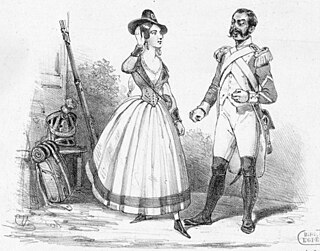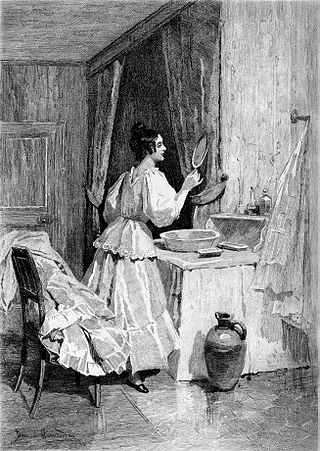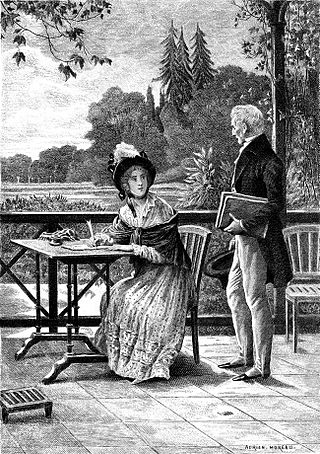
La fille du régiment is an opéra comique in two acts by Gaetano Donizetti, set to a French libretto by Jules-Henri Vernoy de Saint-Georges and Jean-François Bayard. It was first performed on 11 February 1840 by the Paris Opéra-Comique at the Salle de la Bourse.

Honoré de Balzac was a French novelist and playwright. The novel sequence La Comédie humaine, which presents a panorama of post-Napoleonic French life, is generally viewed as his magnum opus.

Biarritz is a city on the Bay of Biscay, on the Atlantic coast in the Pyrénées-Atlantiques department in the French Basque Country in southwestern France. It is located 35 kilometres (22 mi) from the border with Spain. It is a luxurious seaside tourist destination known for the Hôtel du Palais, its casinos in front of the sea, and its surfing culture.

Argenteuil is a commune in the northwestern suburbs of Paris, France. It is located 12.3 km (7.6 mi) from the center of Paris. Argenteuil is a sub-prefecture of the Val-d'Oise department, the seat of the arrondissement of Argenteuil. Argenteuil is part of the Métropole du Grand Paris.

Eugénie Grandet is a novel first published in 1833 by French author Honoré de Balzac. While he was writing it he conceived his ambitious project, La Comédie humaine, and almost immediately prepared a second edition, revising the names of some of the characters so that Eugénie Grandet then fitted into the section: Scenes from provincial life in the Comédie. He dedicated the edition to Maria Du Fresnay, who was then his lover and was the mother of his daughter, Marie-Caroline Du Fresnay.

La Comédie humaine is Honoré de Balzac's 1829–48 multi-volume collection of interlinked novels and stories depicting French society in the period of the Restoration (1815–30) and the July Monarchy (1830–48).

Illusions perdues — in English, Lost Illusions — is a serial novel written by the French writer Honoré de Balzac between 1837 and 1843. It consists of three parts, starting in provincial France, thereafter moving to Paris, and finally returning to the provinces. The book resembles another of Balzac's greatest novels, La Rabouilleuse, that is set in Paris and in the provinces. It forms part of the Scènes de la vie de province in La Comédie humaine.

Le Cousin Pons is one of the last of the 94 novels and short stories that make up Honoré de Balzac’s Comédie humaine. Begun in 1846 as a novella, it was envisaged as one part of a diptych, Les Parents pauvres, along with La Cousine Bette. The book was originally published as a serial in Le Constitutionnel, but during 1847 it grew into a full-length novel, with a male poor relation, Pons, as its subject,

Les Chouans is an 1829 novel by French novelist and playwright Honoré de Balzac (1799–1850) and included in the Scènes de la vie militaire section of his novel sequence La Comédie humaine. Set in the French region of Brittany, the novel combines military history with a love story between the aristocratic Marie de Verneuil and the Chouan royalist Alphonse de Montauran. It takes place during the 1799 post-war uprising in Fougères.

Guy Du Fresnay (1877-1937) was a French writer and silent film director best known for his silent films of the late 1910s and early 1920s. He was awarded the Legion of Honor in 1919.

The Maison de Balzac is a writer's house museum in the former residence of French novelist Honoré de Balzac (1799–1850). It is located in the 16th arrondissement at 47, rue Raynouard, Paris, France, and open daily except Mondays and holidays; admission to the house is free, but a fee is charged for its temporary exhibitions. The nearest métro and RER stations are Passy and Avenue du Président Kennedy.

Le Bal de Sceaux is the fifth work of Honoré de Balzac, one of the oldest texts of la Comédie Humaine.

Mémoires de deux jeunes mariées is an epistolary novel by the French writer Honoré de Balzac. It was serialized in the French newspaper La Presse in 1841 and published by Furne in 1842 as the first work in the second volume of Balzac's La Comédie humaine. It was dedicated to the French novelist George Sand. The 1902 English translation of the novel included a preface by Henry James.

Ursule Mirouët, a novel, belongs to Honoré de Balzac’s series of 94 novels and short stories La Comédie humaine. First published in 1841, it forms part of his Scènes de la vie de province.

Le Curé de Tours is a long short story by Honoré de Balzac, written in 1832. Originally entitled Les Célibataires, it was published in that year in volume III of the 2nd edition of Scènes de la vie privée, then republished in 1833 and again in 1839, still with the same title but as one of the Scènes de la vie de province. Not until 1843 did it take on its present title of Le Curé de Tours when it appeared in volume II of Scènes de la vie de province.

Gambara is a short story by Honoré de Balzac, first published in 1837 in the Revue et gazette musicale de Paris at the request of its editor Maurice Schlesinger. It is one of the Études philosophiques of La Comédie humaine.

Le Cabinet des Antiques is a French novel published by Honoré de Balzac in 1838 under the title les Rivalités en province in le Constitutionnel, then published as a work in its own right in 1838 by the Souverain publishing house.
Marie Du Fresnay, aka Maria du Fresnay, née Daminois (1809-1892), was a French writer.

Rue de la Chaussée in Argenteuil or A Square in Argenteuil is an 1872 painting by Alfred Sisley, now in the Musée d'Orsay, where it has hung since 1986. It was left to the French state in 1906 by Étienne Moreau-Nélaton, who had bought it earlier that year from François Depeaux's collection via the art dealer Georges Petit.


















